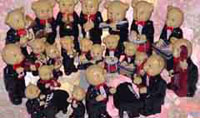Belgian Painters
Above is just a small part of our gift-packed souvenir stamp-collection; inquire by email if the picture or subject of your interest is not here: we will be obliged to accomodate your wishes.
ここに掲載の写真は一部のみです。ご希望のジャンル、絵柄などございましたらお問い合わせください。
Early Netherlandish painting[1] is a term art historians use to designate a group of painters who were active primarily in the Netherlands in the 15th and early 16th centuries. They embodied at the same time the culmination of the Middle Ages and the transition to Renaissance.
The period corresponds to the Italian Renaissance, but the style is generally not seen as a part of the Renaissance[2]. The art is usually categorized as Early Renaissance or Late Gothic painting.
1 Designation
2 Relation with the Italian Renaissance
3 Painters
4
5 References
Designation
"The Ghent Altarpiece: The Adoration of the Lamb" shows how important medieval elements still are.
There is no consensus regarding the name given to this group. The painting is also called Late Gothic, emphasizing the continuity with the Middle Ages[2]. In some languages (for example Dutch and Spanish) they are known as the Flemish Primitives, not because their art lacked sophistication (quite to the contrary), but because they were at the origin of a whole new tradition in painting with the use of oil paint, instead of tempera.
Since Flanders (currently in Belgium) was the leading region in the Netherlands in this period, Flemish and Netherlandish are often used interchangeably. Many of the painters were not Flemish but came to work in the flourishing cities of Bruges and Ghent, which were centers of international banking and trade.
A clear difference with the Italian Renaissance is the importance of religious symbolism. Man is not put in the center of the Universe. Signs of the new age are visible, however. Artists begin to sign their works and become stars instead of craftsmen. Wealthy merchants order paintings for the glory of God, but also request portraits.
Relation with the Italian Renaissance
The new style emerged in Flanders almost simultaneously with the beginning of the Italian Renaissance. The masters were very much admired in Italy, and may have had a bigger influence in Italy then the other way around. Renaissance did not have a big influence in the north until 1500. However, while in Italy we see radical changes in architecture, sculpture and philosophy as well, the revolution in Flanders is restricted to painting[2].
Painters
* Master of Flemalle
* Jan van Eyck
* Hubert van Eyck
* Rogier van der Weyden
* Hugo van der Goes
* Geertgen tot Sint Jans
* Hans Memling
* Petrus Christus
* Robert Campin
* Dirk Bouts
* Gerard David
* List of Belgian painters
* Early Renaissance painting.
The above explanation comes from  出典: フリー百科事典"ウィキペディア"
出典: フリー百科事典"ウィキペディア"
From Wikipedia, the free encyclopedia

